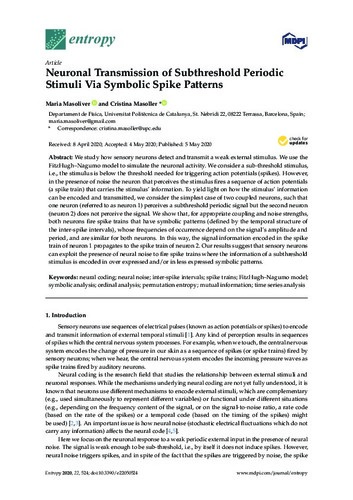Mostra el registre d'ítem simple
Neuronal transmission of subthreshold periodic stimuli via symbolic spike patterns
| dc.contributor.author | Masoliver Vila, Maria |
| dc.contributor.author | Masoller Alonso, Cristina |
| dc.contributor.other | Universitat Politècnica de Catalunya. Departament de Física |
| dc.date.accessioned | 2020-09-17T17:22:13Z |
| dc.date.available | 2020-09-17T17:22:13Z |
| dc.date.issued | 2020-05-05 |
| dc.identifier.citation | Masoliver, M.; Masoller, C. Neuronal transmission of subthreshold periodic stimuli via symbolic spike patterns. "Entropy: international and interdisciplinary journal of entropy and information studies", 5 Maig 2020, vol. 22, núm. 5, p. 524:1-524:12. |
| dc.identifier.issn | 1099-4300 |
| dc.identifier.uri | http://hdl.handle.net/2117/328887 |
| dc.description.abstract | We study how sensory neurons detect and transmit a weak external stimulus. We use the FitzHugh–Nagumo model to simulate the neuronal activity. We consider a sub-threshold stimulus, i.e., the stimulus is below the threshold needed for triggering action potentials (spikes). However, in the presence of noise the neuron that perceives the stimulus fires a sequence of action potentials (a spike train) that carries the stimulus’ information. To yield light on how the stimulus’ information can be encoded and transmitted, we consider the simplest case of two coupled neurons, such that one neuron (referred to as neuron 1) perceives a subthreshold periodic signal but the second neuron (neuron 2) does not perceive the signal. We show that, for appropriate coupling and noise strengths, both neurons fire spike trains that have symbolic patterns (defined by the temporal structure of the inter-spike intervals), whose frequencies of occurrence depend on the signal’s amplitude and period, and are similar for both neurons. In this way, the signal information encoded in the spike train of neuron 1 propagates to the spike train of neuron 2. Our results suggest that sensory neurons can exploit the presence of neural noise to fire spike trains where the information of a subthreshold stimulus is encoded in over expressed and/or in less expressed symbolic patterns. |
| dc.description.sponsorship | This research was funded by the Spanish Ministerio de Ciencia, Innovación y Universidades (No. PGC2018-099443-B-I00) and ICREA ACADEMIA, Generalitat de Catalunya. |
| dc.language.iso | eng |
| dc.rights | Attribution 4.0 |
| dc.rights.uri | https://creativecommons.org/licenses/by/4.0/ |
| dc.subject | Àrees temàtiques de la UPC::Física |
| dc.subject.lcsh | Sensory neurons |
| dc.subject.lcsh | Time-series analysis |
| dc.subject.other | Neural coding |
| dc.subject.other | Neural noise |
| dc.subject.other | Inter-spike intervals |
| dc.subject.other | Spike trains |
| dc.subject.other | FitzHugh–Nagumo model |
| dc.subject.other | Symbolic analysis |
| dc.subject.other | Ordinal analysis |
| dc.subject.other | Permutation entropy |
| dc.subject.other | Mutual information |
| dc.subject.other | Time series analysis |
| dc.title | Neuronal transmission of subthreshold periodic stimuli via symbolic spike patterns |
| dc.type | Article |
| dc.subject.lemac | Neurones sensorials |
| dc.subject.lemac | Sèries temporals -- Anàlisi |
| dc.contributor.group | Universitat Politècnica de Catalunya. DONLL - Dinàmica no Lineal, Òptica no Lineal i Làsers |
| dc.identifier.doi | 10.3390/E22050524 |
| dc.description.peerreviewed | Peer Reviewed |
| dc.relation.publisherversion | https://www.mdpi.com/1099-4300/22/5/524 |
| dc.rights.access | Open Access |
| local.identifier.drac | 28997140 |
| dc.description.version | Postprint (published version) |
| dc.relation.projectid | info:eu-repo/grantAgreement/AEI/Plan Estatal de Investigación Científica y Técnica y de Innovación 2017-2020/PGC2018-099443-B-I00/ES/SISTEMAS DINAMICOS COMPLEJOS Y HERRAMIENTAS AVANZADAS DE ANALISIS DE DATOS/ |
| local.citation.author | Masoliver, M.; Masoller, C. |
| local.citation.publicationName | Entropy: international and interdisciplinary journal of entropy and information studies |
| local.citation.volume | 22 |
| local.citation.number | 5 |
| local.citation.startingPage | 524:1 |
| local.citation.endingPage | 524:12 |
Fitxers d'aquest items
Aquest ítem apareix a les col·leccions següents
-
Articles de revista [341]
-
Articles de revista [2.208]


